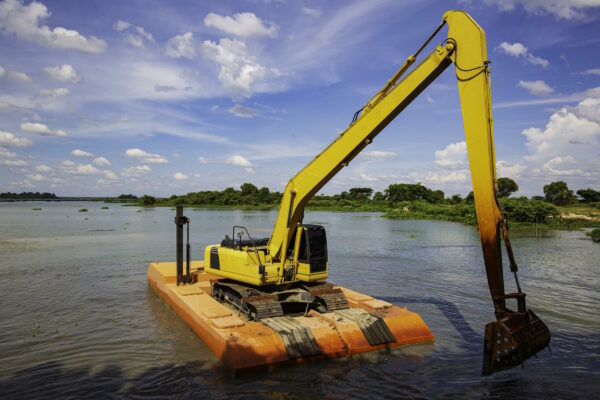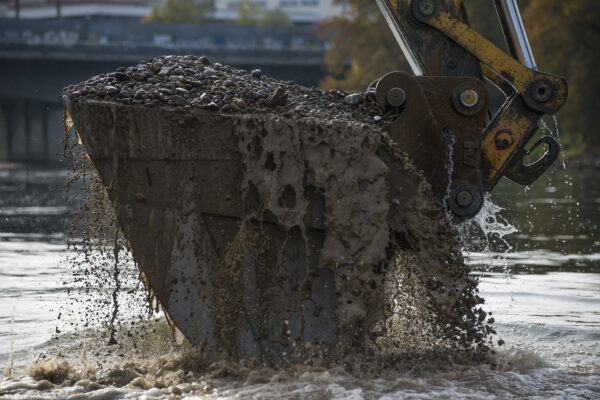A regular excavator is designed to work on firm-to-loose ground (e.g. gravel and stones), and shallow mud or water, but if there’s a requirement to work in very deep mud or in deep water, a different strategy is required to keep the tracks from sinking in too far, or water entering the engine and components.
The most common solution is an amphibious excavator which will work on both land and water. These are also called pontoon excavators and feature buoyant attachments to stop the excavator sinking; the excavator operator must be experienced and smooth as they are much easier to tip if they are floating on water..
They tend to use non-toxic biodegradable oil instead of hydraulic fluid, and use lithium grease as it resists washing off by water.

What work can excavators do in the water?
Nine types of work amphibious excavators can complete:
- Construction of docks, bridges and caissons
- Dredging (e.g. digging sand from a riverbed or the seabed)
- Flood control (e.g. removing a build-up of debris that could overwhelm a bridge, or repairing a levee)
- Cleaning up rivers and streams (e.g. removing vegetation to improve flow)
- Mining (e.g. clearing material from inundated pits)
- Vehicle rescue (e.g. retrieving a vehicle that has gone into a river or lake)
- Sea- or riverbed preparation (e.g. preparing for construction)
- Retrieving sunken vessels and their cargo (e.g. moving the vessel or lifting cargo)
- Laying cables and pipes (e.g. fibre optic cable trenches)
In these cases, the body of the excavator remains above the level of the water. However, there are also specialised excavators that can work in much deeper water.

For some of the above work, excavation could also be achieved from the shore with the use of a much longer boom – cleaning up rivers and streams, or dredging stones from a riverbed are a good examples of this.

It’s critical that training in excavator operation is carried out before attempting to use an excavator in water.
Fast-flowing water
Dangers arise with fast-flowing water. Even though an excavator is heavy, it is possible for the pressure of the water to move it. If it moves the excavator towards the excavation, this can destabilise the excavator and it could tip over. The water can also undermine the tracks or wheels.
When operating an excavator in flowing water or water that is getting deeper, use the boom to keep testing the water level.
Corrosion
Using an excavator in water increases corrosion, especially saltwater. Items such as slewing motors and final drive motors may need to be regreased after use.
Permits
A permit or other permission may be required to use the excavator on sensitive wetland areas or bodies of water. There may be environmental restrictions and requirements to remove spoil.
